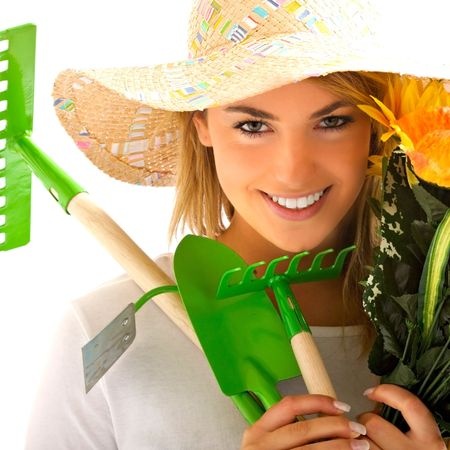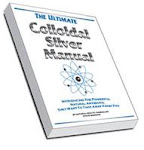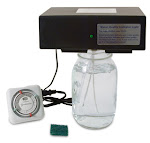Have you ever wondered
about using colloidal silver in your garden, to control plant fungus and other
infections that can destroy crops, or dramatically limit crop yields?
Well, here’s an
interesting study demonstrating the fact that antimicrobial silver is not only
effective against plant fungus, but also helps increase crop quality and size. Here’s what you need to know…
Hi, Steve Barwick here, for TheSilverEdge.com…
In this breakthrough study,
published in the March 2010 issue of the journal Mycobiology, researchers found that applying varying levels of
silver nanoparticles to the roots of green onion plants completely eradicated Sclerotium cepivorum fungal infections
known to destroy the plants.
Not only did the application of silver nanoparticles destroy
the pathogenic plant fungus, but according to the study authors, it caused no significant
harm to beneficial soil microbes needed by the green onion plants for growth,
nor was there any negative change in the soil chemistry or composition.
Bigger and Better
Crops
What’s more, the nanosilver-treated green onion plants, once
harvested, were demonstrated to have grown larger and to weigh more than the
non-treated green onion plants.
According to the researchers:
“We
applied different concentrations of nanosilver (10 ppm, 23 ppm, 50 ppm, and 100
ppm) at the base of each plant four times each week for up to four weeks.
After
five months, the roots of the plants were observed and the dry weight was
measured after drying it in the drying machine at 80 degrees.
The
fresh weight of the harvested green onion was also measured.
…Both
the fresh weight and the dry weight of the treated plants increased. The onions treated with the nanosilver liquid
had more weight than the non-treated or controls.”
That’s astonishing, of course, because it means the use of
antimicrobial silver actually increased crop weight and therefore crop yield as
well.
Do the Plants Know
How Much Silver They Need?
Finally, the researchers pointed out that the more they
increased the use of nanosilver on the green onion plants in order to test what
higher levels of silver would do to the plants, the less silver the plants absorbed.
The researchers stated, “When
the amount of nano-silver was calculated in the plants grown in nano-silver
treated soil, it was found that the concentration of nano-silver used for
treatment and the concentration of nano-silver found in the plants was
inversely proportional.”
In other words, the plants themselves apparently reduce absorption of the silver when high
levels are used on them to control the plant blight.
This appears to mean the plants only absorbed what they needed
for protection and healing, and then stop absorbing the silver after protective
levels have been reached.
Staggering
Implications
The conclusion drawn by the study researchers was staggering
in its implications.
If further studies demonstrate these same results to be applicable
to all crops, it would revolutionize farming (and gardening as well).
The researchers wrote:
“This research has shown that nano-silver liquid can increase plant
productivity and reduce environmental pollution…
…Nano-silver
liquid for the prevention of various plant pathogenic fungi is highly
recommended to farmers.
Additionally…it
is safe for the environment and agricultural products.
In
conclusion, we can say that by using nano-silver liquid, environmental
pollution and the excessive use of chemical compounds in the field can be
reduced.
It
is expected that the application of nano-silver at low concentrations will be
economic, eco-friendly, and decrease farm management costs.”
Gardeners have reported great results like this for
decades. But of course, anecdotal
accounts don’t prove anything. They are
just indicators.
It is studies like the above that provide bona-fide
documentation of silver’s highly beneficial uses for crop plants.
Why Does the Silver Work So Well?
According to the Journal of Food and Chemistry, the reason silver works against
plant fungi is that it’s rapidly taken up by fungal spores, which in turn stops
germination of the fungus.
"Silver is taken
up rapidly by fungus spores, so that germination can be completely inhibited
after a contact time of 1 minute or less.
Only mercury( I) and
(II), and to a lesser extent copper, offer serious competition."
-- Miller, Lawrence P., and McCallan, S.E.A. 1957. Toxic action of metal ions to fungus spores.
Agricultural and Food Chemistry, 5(2), 116-122.
It’s interesting to note that the above quote is from a
study published way back in 1957. This
means silver’s effectiveness against fungal pathogens that harm crops has been
known for over 55 years.
And yet, because of resistance from the giant chemical
conglomerates which supply the potentially toxic synthetic chemicals used in
farming, the use of antimicrobial silver to stop plant blight and associated
fungal infections has still never been implemented on a wide scale basis in
farming.
Of course, the radical anti-silver environmentalists will
scream bloody murder and argue that silver nanoparticles should not be used on
plant crops because they pose an imminent “danger to the environment.”
This, in spite of the fact that the latest studies have
demonstrated there is no
ecoloigcal harm whatsoever from silver in the environment. (Not to mention the fact that silver comes from the environment in the first
place.)
So you have to look at underlying agenda when you hear these
loud and sensationalistic cries against the use of silver coming from radical
elements within the environmental community.
Often, those who claim to be “protecting the environment,”
are in reality merely protecting the global corporate masters who would lose hundreds
of billions of dollars in profits if their synthetic chemicals were no longer
being used.
More Research and
Personal Experiences
The bottom line is this:
A growing body of research is clearly demonstrating the fact
that silver has its place in crop disease management, and should be used in
place of the potentially toxic chemicals presently being used, and that are
losing their effectiveness against pathogens.
Far from damaging or harming crop plants, silver appears to help
save them from plant blight, and even increases the overall quality and yield of
the crops without causing harm to the soil or surrounding environment.
Independent research seems to dovetail with the results
achieved by the researchers in the above study.
For example, Brooks Bradley, of the Harborne Research
Foundations has stated of his experiments with the topical use of colloidal silver
on plant crops and shrubs:
"...we
performed some limited, plant-oriented evaluations utilizing colloidal silver.
Our
initial investigation involved experiments designed to determine if colloidal
silver would yield beneficial effects on 'fire-blight' associated with pear
trees and pyracantha shrubs.
The
only effective protocol we had found, prior to our colloidal silver
evaluations, was the application of streptomycin (water soluble form) in an
aerosol spray.
A solution of 10 ppm strength colloidal silver mixed at the rate of 1 pint colloidal silver to 2.5 gallons of water and 1/4 teaspoon household detergent was applied to affected trees (in various states of challenge, from 10% to 50% foliage involvement).
Visually detectable improvement manifested within 48 hours. Marked improvement and pathogenic stabilization evidenced within 72 hours.
A solution of 10 ppm strength colloidal silver mixed at the rate of 1 pint colloidal silver to 2.5 gallons of water and 1/4 teaspoon household detergent was applied to affected trees (in various states of challenge, from 10% to 50% foliage involvement).
Visually detectable improvement manifested within 48 hours. Marked improvement and pathogenic stabilization evidenced within 72 hours.
New
leaf growth---in former areas of heavy attack---started to appear within 7 days
of the initial treatment.
This
protocol was repeatable (we performed it 4 times)."
And as Dr. Keith F. Courtenay (U.L.C., USA) has stated in
his book, Colloidal Silver: the Hidden
Truths:
"For
all bacterial, fungal and viral attacks on plants, flowers and fruit, simply
spray diluted colloidal silver on the leaves; also, add to water, mixing one
tablespoon per liter.
I
put silver in my hydroponic system to eradicate root rot. A friend of mine
grows very rare orchids; these are sold overseas for a large amount of money.
He was getting a fungus growing on some of them and they became worthless.
We
came up with the idea that the silver might eradicate the fungus, as it does on
humans and animals. So why not give it a try?
It
worked and he is a very happy man. He
has now put a spray system in and all his flowers are sprayed at regular
intervals and have never had any trouble since."
As house plant enthusiast Lisa B. recently wrote on the
Colloidal Silver Secrets Community on Facebook:
And as another plant enthusiast wrote on the Colloidal
Silver Secrets Community on Facebook:
“I add about 1/2 ounce of colloidal silver to the water when I am rooting
plant cuttings. No more stagnant water with rotted cuttings.”
On the WebMD.com website, you’ll find the following colloidal silver and
plant testimonial from an avid gardener:
“I
use it my garden. You should see how lush my Tomato plants look and my Zucchini
plants. Wow!
I
even spray it on my roses and it gets rid of the aphids and the roses are
brilliant in color.”
My wife Kathy has been experimenting with the use of
colloidal silver in her garden for many years now. She’s used it a number of times to eradicate tomato
plant fungus, and has noted that the tomatoes on the treated plants always seem
to be redder and juicier and plumper than tomatoes on untreated plants.
Over the past couple of years she’s also used it,
moderately, in the soil around plants that seemed to be infected or were having
trouble growing vegetables. As I wrote
several years ago in an article “Environmentalists Claim Silver Nanoparticles a
Threat to Plant Life”:
“I
know of dozens of people who use nanoscale colloidal silver to keep their
plants healthier, and make their fruits and vegetables grow faster and stronger
in their home gardens.
A
non-published experiment during the last growing season demonstrated that
tomato seeds planted in soil treated with small amounts of nanosilver produced
30% more sprouts than the same amount of seeds planted in non-silver-treated
soil.
What’s
more, the plants grew nearly twice as fast over the first 15 days of the
experiment before leveling out and growing normally after that. They
started out faster, and stayed larger and hardier than the plants in the
non-silver-treated soil. That’s a sign of superior health. Not harm.
My
wife sprayed her garden with nano-scale colloidal silver all growing season long last year, at
least once every week, and sometimes twice…
…and she won a blue ribbon first-place award for her veggies at the local fair. (Not to mention feeding me week after week all summer long with fresh organic squash, tomatoes, black berries, artichokes, cantaloupe and more!)
What’s
more, for the first time in over 10 years of gardening, her garden was still
producing crops all of the way through to early of November, well after the
first frost!
I
won’t even mention the pot growers who use colloidal silver to produce more potent pot buds.”
For additional information on using colloidal silver in
gardening, see Angela Kaelin’s great article, “Using Colloidal Silver for
Healthier Fruits and Vegetables.”
Meanwhile, I’ll be back next week with another great article on
colloidal silver….
Yours for the safe, sane and responsible
use of colloidal silver,
Steve Barwick, author
The Ultimate Colloidal Silver Manual
The Ultimate Colloidal Silver Manual
Helpful Links:
Important Note and
Disclaimer: The contents of this Ezine have not been
evaluated by the Food and Drug Administration.
Information conveyed herein is from sources deemed to be accurate and
reliable, but no guarantee can be made in regards to the accuracy and
reliability thereof. The author, Steve
Barwick, is a natural health journalist with over 30 years of experience
writing professionally about natural health topics. He is not
a doctor. Therefore, nothing stated in
this Ezine should be construed as prescriptive in nature, nor is any part of
this Ezine meant to be considered a substitute for professional medical
advice. Nothing reported herein is
intended to diagnose, treat, cure or prevent any disease. The author is simply reporting in
journalistic fashion what he has learned during the past 17 years of
journalistic research into colloidal silver and its usage. Therefore, the information and data presented
should be considered for informational purposes only, and approached with
caution. Readers should verify for
themselves, and to their own satisfaction, from other knowledgeable sources
such as their doctor, the accuracy and reliability of all reports, ideas,
conclusions, comments and opinions stated herein. All important health care decisions should be
made under the guidance and direction of a legitimate, knowledgeable and
experienced health care professional.
Readers are solely responsible for their choices. The author and publisher disclaim
responsibility and/or liability for any loss or hardship that may be incurred
as a result of the use or application of any information included in this
Ezine.
Copyright
2014 | Life & Health Research Group, LLC | PO Box 1239 | Peoria AZ
85380-1239 | All rights reserved.










No comments:
Post a Comment